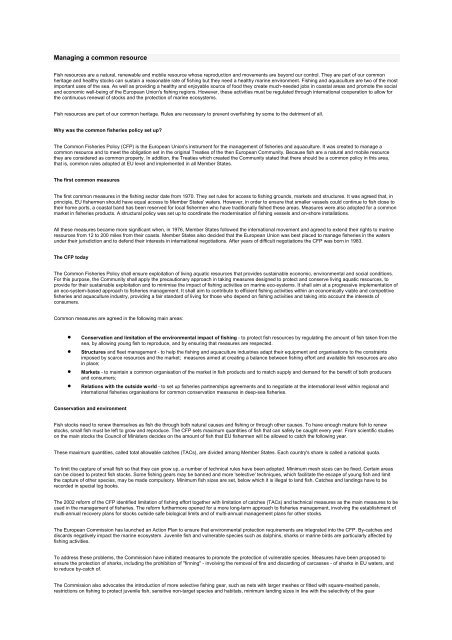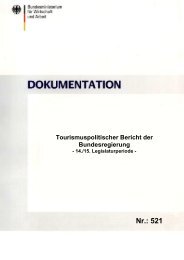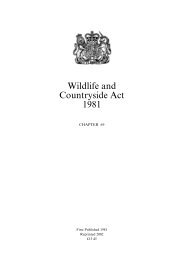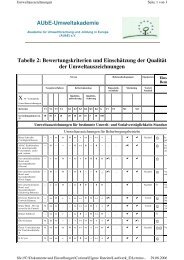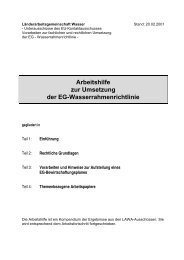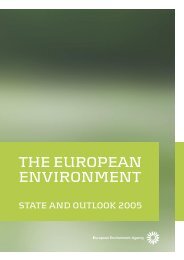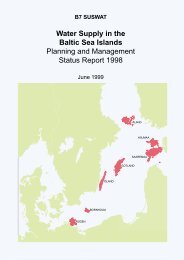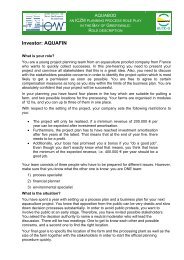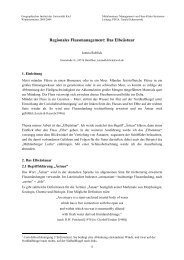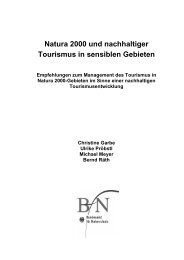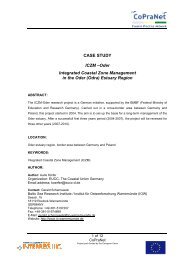Managing a common resource - IKZM-D Lernen
Managing a common resource - IKZM-D Lernen
Managing a common resource - IKZM-D Lernen
You also want an ePaper? Increase the reach of your titles
YUMPU automatically turns print PDFs into web optimized ePapers that Google loves.
<strong>Managing</strong> a <strong>common</strong> <strong>resource</strong><br />
Fish <strong>resource</strong>s are a natural, renewable and mobile <strong>resource</strong> whose reproduction and movements are beyond our control. They are part of our <strong>common</strong><br />
heritage and healthy stocks can sustain a reasonable rate of fishing but they need a healthy marine environment. Fishing and aquaculture are two of the most<br />
important uses of the sea. As well as providing a healthy and enjoyable source of food they create much-needed jobs in coastal areas and promote the social<br />
and economic well-being of the European Union's fishing regions. However, these activities must be regulated through international cooperation to allow for<br />
the continuous renewal of stocks and the protection of marine ecosystems.<br />
Fish <strong>resource</strong>s are part of our <strong>common</strong> heritage. Rules are necessary to prevent overfishing by some to the detriment of all.<br />
Why was the <strong>common</strong> fisheries policy set up?<br />
The Common Fisheries Policy (CFP) is the European Union's instrument for the management of fisheries and aquaculture. It was created to manage a<br />
<strong>common</strong> <strong>resource</strong> and to meet the obligation set in the original Treaties of the then European Community. Because fish are a natural and mobile <strong>resource</strong><br />
they are considered as <strong>common</strong> property. In addition, the Treaties which created the Community stated that there should be a <strong>common</strong> policy in this area,<br />
that is, <strong>common</strong> rules adopted at EU level and implemented in all Member States.<br />
The first <strong>common</strong> measures<br />
The first <strong>common</strong> measures in the fishing sector date from 1970. They set rules for access to fishing grounds, markets and structures. It was agreed that, in<br />
principle, EU fishermen should have equal access to Member States' waters. However, in order to ensure that smaller vessels could continue to fish close to<br />
their home ports, a coastal band has been reserved for local fishermen who have traditionally fished these areas. Measures were also adopted for a <strong>common</strong><br />
market in fisheries products. A structural policy was set up to coordinate the modernisation of fishing vessels and on-shore installations.<br />
All these measures became more significant when, in 1976, Member States followed the international movement and agreed to extend their rights to marine<br />
<strong>resource</strong>s from 12 to 200 miles from their coasts. Member States also decided that the European Union was best placed to manage fisheries in the waters<br />
under their jurisdiction and to defend their interests in international negotiations. After years of difficult negotiations the CFP was born in 1983.<br />
The CFP today<br />
The Common Fisheries Policy shall ensure exploitation of living aquatic <strong>resource</strong>s that provides sustainable economic, environmental and social conditions.<br />
For this purpose, the Community shall apply the precautionary approach in taking measures designed to protect and conserve living aquatic <strong>resource</strong>s, to<br />
provide for their sustainable exploitation and to minimise the impact of fishing activities on marine eco-systems. It shall aim at a progressive implementation of<br />
an eco-system-based approach to fisheries management. It shall aim to contribute to efficient fishing activities within an economically viable and competitive<br />
fisheries and aquaculture industry, providing a fair standard of living for those who depend on fishing activities and taking into account the interests of<br />
consumers.<br />
Common measures are agreed in the following main areas:<br />
• Conservation and limitation of the environmental impact of fishing - to protect fish <strong>resource</strong>s by regulating the amount of fish taken from the<br />
sea, by allowing young fish to reproduce, and by ensuring that measures are respected.<br />
• Structures and fleet management - to help the fishing and aquaculture industries adapt their equipment and organisations to the constraints<br />
imposed by scarce <strong>resource</strong>s and the market; measures aimed at creating a balance between fishing effort and available fish <strong>resource</strong>s are also<br />
in place;<br />
• Markets - to maintain a <strong>common</strong> organisation of the market in fish products and to match supply and demand for the benefit of both producers<br />
and consumers;<br />
• Relations with the outside world - to set up fisheries partnerships agreements and to negotiate at the international level within regional and<br />
international fisheries organisations for <strong>common</strong> conservation measures in deep-sea fisheries.<br />
Conservation and environment<br />
Fish stocks need to renew themselves as fish die through both natural causes and fishing or through other causes. To have enough mature fish to renew<br />
stocks, small fish must be left to grow and reproduce. The CFP sets maximum quantities of fish that can safely be caught every year. From scientific studies<br />
on the main stocks the Council of Ministers decides on the amount of fish that EU fishermen will be allowed to catch the following year.<br />
These maximum quantities, called total allowable catches (TACs), are divided among Member States. Each country's share is called a national quota.<br />
To limit the capture of small fish so that they can grow up, a number of technical rules have been adopted. Minimum mesh sizes can be fixed. Certain areas<br />
can be closed to protect fish stocks. Some fishing gears may be banned and more 'selective' techniques, which facilitate the escape of young fish and limit<br />
the capture of other species, may be made compulsory. Minimum fish sizes are set, below which it is illegal to land fish. Catches and landings have to be<br />
recorded in special log books.<br />
The 2002 reform of the CFP identified limitation of fishing effort together with limitation of catches (TACs) and technical measures as the main measures to be<br />
used in the management of fisheries. The reform furthermore opened for a more long-term approach to fisheries management, involving the establishment of<br />
multi-annual recovery plans for stocks outside safe biological limits and of multi-annual management plans for other stocks.<br />
The European Commission has launched an Action Plan to ensure that environmental protection requirements are integrated into the CFP. By-catches and<br />
discards negatively impact the marine ecosystem. Juvenile fish and vulnerable species such as dolphins, sharks or marine birds are particularly affected by<br />
fishing activities.<br />
To address these problems, the Commission have initiated measures to promote the protection of vulnerable species. Measures have been proposed to<br />
ensure the protection of sharks, including the prohibition of "finning" - involving the removal of fins and discarding of carcasses - of sharks in EU waters, and<br />
to reduce by-catch of.<br />
The Commission also advocates the introduction of more selective fishing gear, such as nets with larger meshes or fitted with square-meshed panels,<br />
restrictions on fishing to protect juvenile fish, sensitive non-target species and habitats, minimum landing sizes in line with the selectivity of the gear
concerned, "discard ban trials" in which representative samples of fishing vessels would be encouraged through economic incentives to retain their entire<br />
catch and the development of economic incentives for the use of more selective fishing practices.<br />
Structures and fleet management<br />
The EU's structural policy helps the fishing sector adapt to today's needs. Funding is available from the Financial Instrument for Fisheries Guidance (FIFG) for<br />
projects in all branches of fishing and aquaculture and for measures to identify and promote new market outlets. Funding is available for modernisation of the<br />
fishing fleets as well as for getting rid of excess fishing capacity.<br />
The main measures co-financed by the FIFG are the following:<br />
• Adjustment of fishing effort and temporary cessation of fishing activities<br />
• Modernisation of the fishing fleet<br />
• Small-scale costal fishing<br />
• Temporary cessation of fishing activities<br />
• Socio-economic measures<br />
• Support for aquaculture, processing, marketing and port facilities<br />
• Collective measures taken by the industry<br />
The FIFG covers the period 2000-2006 and it will be replaced by the European Fisheries Fund (EFF) covering the period 2007-2013.<br />
As regards fleet management, the 2002 CFP reform introduced a simpler system for limiting the fishing capacity of the EU fleet in order to reach a better<br />
match with available <strong>resource</strong>s has been adopted. It replaced the former system of Multi-annual Guidance Programmes (MAGPs) which had proved to be<br />
ineffective at tackling the overcapacity of the EU fleet. The new system gives more responsibility to the Member States to achieve a better balance between<br />
the fishing capacity of their fleets and the available <strong>resource</strong>s.<br />
Reference levels will be set based on the MAGP levels set for 31 December 2002. The reference levels will be automatically and permanently reduced<br />
whenever any capacity is withdrawn with public aid. (If a vessel is withdrawn with public aid the reference levels will be reduced by and equivalent capacity).<br />
In addition, each vessel entering the fleet shall be compensated by the withdrawal of at least an equivalent capacity.<br />
The <strong>common</strong> organisation of the market<br />
This policy was part of the first set of <strong>common</strong> measures. The objective is to create a <strong>common</strong> market inside the European Union and to match production to<br />
demand for the benefit of both producers and consumers. These original objectives have been complemented by the creation of the European single market<br />
and the gradual opening up of world trade.<br />
The <strong>common</strong> organisation has four components:<br />
• <strong>common</strong> marketing standards for fresh products on quality, grades, packaging and labelling of both EU and imported fisheries products;<br />
• producers' organisations (POs), which are voluntary associations of fishermen set up to help stabilise markets. Their role is to protect fishermen<br />
from sudden changes in market demand;<br />
• a price support system which sets minimum prices below which fish products cannot be sold. Financial support is available to POs if they have to<br />
take fish and shellfish off the market, store them for later use or process them;<br />
• rules for trade with non-EU countries.<br />
The aim is to balance the needs of the EU market and the interests of European Union fishermen and to ensure that the rules on fair competition are<br />
respected.<br />
Relations with third countries<br />
At the bilateral and multilateral levels, fisheries agreements became necessary when distant-fishing vessels from the European Union lost access to their<br />
traditional grounds following the extension of fisheries zones. Fishing rights for such vessels have been negotiated with many non-EU countries in return for<br />
various forms of compensation whose nature depends on the interests of the third country concerned.<br />
In the context of the 2002 CFP reform, the Community initiated a move from access agreements to “Partnership agreements” which contribute to responsible<br />
fishing in the mutual interest of the Parties concerned. The agreements targeted here are those which involve the payment of a financial compensation in<br />
return for access to identified fishing possibilities for EU vessels in the waters under the jurisdiction of a third coastal state. It is felt that it is necessary to<br />
widen the scope of the EU financial contribution. This contribution mainly covers expenditure linked to management costs, the scientific assessment of fish<br />
stocks, fisheries management, and control and monitoring of fishing activities, as well as expenditure for the follow-up and evaluation of the agreement. In<br />
future, this contribution will be justified by the mutual interest of the two parties to invest in a sustainable fisheries policy and not just as a payment for access<br />
rights to fishing possibilities. The EU financial contribution should be regarded as an investment for the improvement of responsible and rational fishing.<br />
The Community is also active in negotiations with international organisations and regional fisheries organisations to ensure rational fishing.<br />
Enforcement<br />
Fishing regulations are necessary to protect fish stocks and to ensure the future of the fishing industry. Disregarding regulatory measures would result in<br />
overfishing, damage to commercial stocks and, ultimately, ruin for the whole industry. Monitoring of regulations is, therefore, crucial to effective fisheries<br />
management. Control plays a central role in encouraging compliance, deterring fraud and ensuring sustainable fishing.<br />
The authorities in the Member States have to ensure that CFP rules are respected. There is also an EU Inspectorate with a staff of 25 inspectors. Their role is<br />
to ensure that all national enforcement authorities apply the same standards of quality and fairness in their enforcement.
In the context of the 2002 CFP reform it was decided to strengthen the control area by setting up an EU Fisheries Control Agency. The Agency will strengthen<br />
the uniformity and effectiveness of enforcement by pooling EU and national means of fisheries control and monitoring <strong>resource</strong>s and co-ordinating<br />
enforcement activities. This operational co-ordination will help tackle the shortcomings in enforcement resulting from the disparities in the means and priorities<br />
of the control systems in the Member States.


